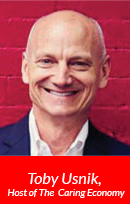 As we stand on the cusp of 2025, it’s time to reflect on the transformative power of purpose-driven leadership and its potential to shape a brighter future. The Caring Economy podcast has been a beacon for those seeking to align their personal and professional lives with meaningful causes, and as we look ahead, the lessons learned from our inspiring guests offer a roadmap for the coming year.
As we stand on the cusp of 2025, it’s time to reflect on the transformative power of purpose-driven leadership and its potential to shape a brighter future. The Caring Economy podcast has been a beacon for those seeking to align their personal and professional lives with meaningful causes, and as we look ahead, the lessons learned from our inspiring guests offer a roadmap for the coming year.
Throughout 2024, we’ve had the privilege of hosting visionaries who have redefined success in business and philanthropy. From Sam Caplan’s innovative approach to leveraging technology for social good to Dave Woodruff’s unwavering commitment to veterans’ causes, these leaders have demonstrated that profit and purpose are not mutually exclusive. Their stories serve as a powerful reminder that when we lead with intention and compassion, we can create ripples of positive change that extend far beyond our immediate sphere of influence.
In these increasingly polarizing times, where societal divisions seem to deepen and global challenges loom large, purpose-driven leaders and brands are emerging as beacons of hope and stability. They are better prepared to navigate the unknown, not because they have all the answers, but because they have a North Star guiding their decisions. This sense of purpose brings a newfound sense of adventure to work, transforming daily tasks into meaningful contributions to a larger mission.
Consider the environmental crises we face – from climate change to biodiversity loss. Purpose-driven companies like Patagonia have long been at the forefront of addressing these issues. Their commitment to environmental stewardship is woven into the very fabric of their business model. By donating 1% of sales to grassroots environmental groups since 1985, Patagonia has shown that profitability and planetary well-being can go hand in hand. As we chart our course for 2025, business leaders would do well to consider how they can integrate similar practices into their operations, viewing environmental challenges not as obstacles, but as opportunities for innovation and positive impact.
The concept of purpose-driven leadership isn’t confined to environmental causes. In the face of growing economic inequality, companies like LEGO have demonstrated how a clear purpose can drive both social impact and business success. By centering its mission on inspiring and developing the builders of tomorrow, LEGO transformed from a company experiencing significant losses to one of the world’s most successful brands. This remarkable turnaround serves as a testament to the power of purpose in driving both innovation and financial success, even in turbulent economic times.
As we contemplate our resolutions for 2025, let’s draw inspiration from these purpose-driven trailblazers. Consider Lynne Hughes, founder of Comfort Zone Camp, whose personal experience with childhood loss fueled her mission to support bereaved children. Her work exemplifies how personal adversity can be transformed into a force for good, touching countless lives in the process. As we set our goals for the new year, we might ask ourselves: How can our own challenges become catalysts for positive change in our communities?
The journey towards purpose-driven leadership often begins with introspection. As Baron Raj Loomba shared on our podcast, his personal experiences of loss and hardship in India led him to become a champion for widows and their children on a global scale. His story reminds us that our most profound motivations often stem from our own life experiences. As we contemplate our resolutions for 2025, we should look inward and ask: What experiences have shaped us, and how can we use them to create meaningful change?
In an era of rapid technological advancement and artificial intelligence, purpose-driven leaders are uniquely positioned to ensure that these tools are used for the betterment of humanity. As we’ve explored on The Caring Economy, leaders who ground their work in a strong sense of purpose are more likely to consider the ethical implications of new technologies and strive to harness their potential for good. This forward-thinking approach not only prepares them for the unknown but also instills a sense of excitement and adventure in tackling complex challenges.
For those in marketing and communications, Caitlin Dodge’s insights on blending innovation with social good offer a compelling vision for the future of brand storytelling. In an era where consumers increasingly demand authenticity and social responsibility from the brands they support, purpose-driven marketing is not just a trend but a necessity. As we plan our strategies for 2025, we should consider how we can authentically communicate our values and purpose to resonate with an increasingly conscious consumer base.
The transition to purpose-driven leadership isn’t always smooth, but it’s invariably rewarding. Jonathan Keyser’s journey in building a commercial real estate firm based on selfless service demonstrates that even in highly competitive industries, there’s room for a purpose-led approach. His success story challenges us to rethink traditional business models and consider how we can infuse our work with a greater sense of purpose and service to others.
As we look to 2025, it’s clear that the most successful leaders will be those who can balance purpose, profit, and legacy. The examples set by Richard Branson and Jean Oelwang through initiatives like Virgin Unite and The B Team show us that business can be a powerful force for good on a global scale. Their work in developing frameworks for more sustainable and human-centric business practices provides a blueprint for leaders looking to make a significant impact in the coming year.
For those feeling uncertain about how to begin their purpose-driven journey, remember that small steps can lead to significant change. As Tom Webster reflected on his two-decade career in podcasting, he emphasized the importance of “working on the garden” – creating the conditions that allow for future growth and success in your chosen field. This approach can be applied to purpose-driven leadership as well. Start by identifying the values that drive you and look for opportunities to align your daily work with these principles.
The adventure of purpose-driven leadership lies in its ability to transform the mundane into the meaningful. It’s about seeing the bigger picture in everyday tasks and understanding how each action contributes to a larger goal. This perspective brings a sense of excitement and fulfillment to work, turning challenges into opportunities for growth and impact.
In these polarizing times, purpose-driven leaders have the power to bridge divides and find common ground. They remind us that despite our differences, we all share a desire for meaning and positive impact. By leading with purpose, we can create spaces for dialogue, understanding, and collaborative problem-solving, even in the face of seemingly insurmountable challenges.
By embracing purpose-driven leadership, we can create a ripple effect of positive change that extends far beyond our immediate sphere of influence. As we’ve learned from the remarkable individuals featured on The Caring Economy, when we lead with purpose, we don’t just change our businesses or careers – we change the world. And in doing so, we transform the unknown from a source of fear into an exciting frontier of possibility, bringing a true sense of adventure to our work and lives.
Tune into our weekly conversation and share your comments via Twitter to @Tusnik or on LinkedIn with @TobyUsnik.
































